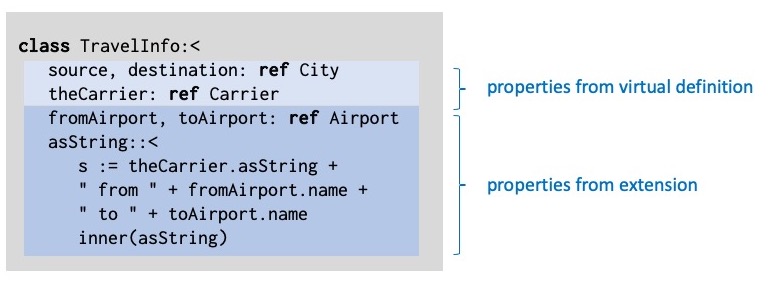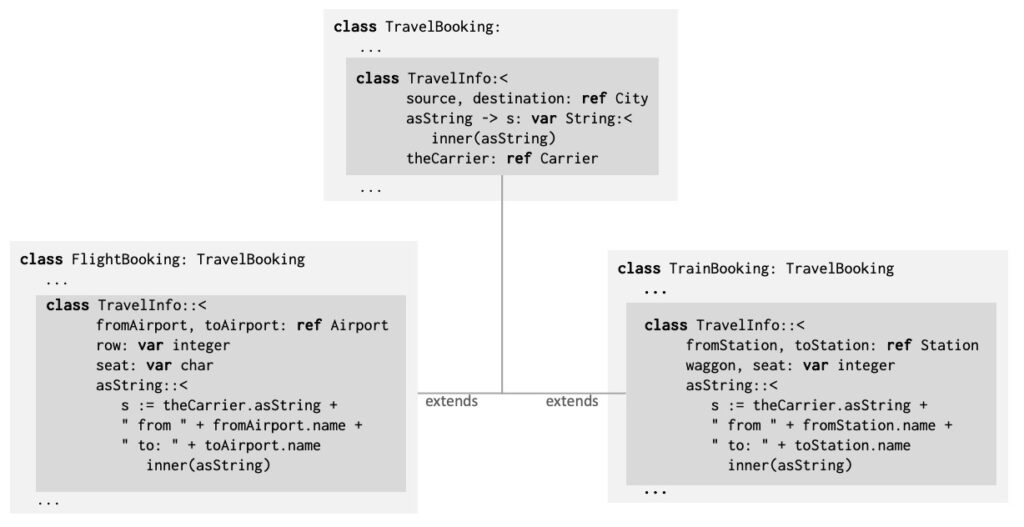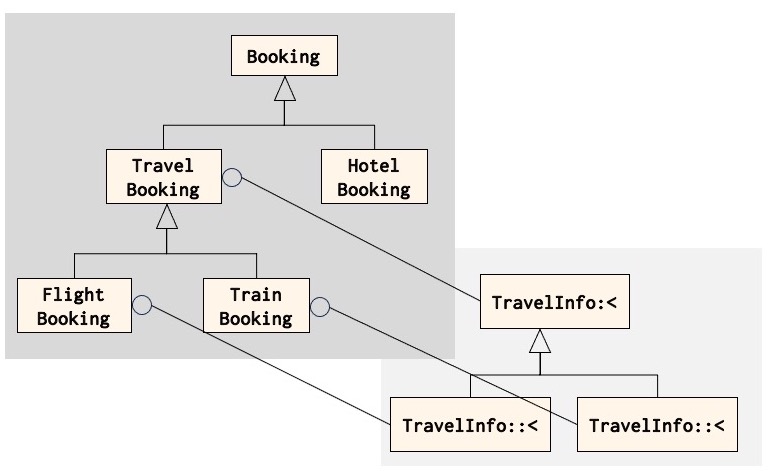As a first example of a virtual class attribute, we extend the travel booking system introduced in section . We will encapsulate details about a travel booking in a local nested virtual class TravelInfo as shown in the example below:
class TravelBooking: Booking
class TravelInfo:<
source, destination: ref City
asString -> s: var String:<
inner(asString)
theCarrier: ref Carrier
theTravel: obj TravelInfo
confirm::<
confirmText := confirmText + theTravel.asString
cancel:
theTravel.theCarrier.notifyCancellation(bookingRef)The symbol ':<' specifies that class TravelInfo is virtual in the same way as for virtual methods. TravelInfo has the following attributes:
- The
sourceanddestinationof the travel. - A method
asString, that returns a text about travel details that may be emailed to the customer.
The virtual class TravelInfo is an example of a self-constrained virtual class, which is a virtual class that is constrained by an object descriptor specifying the virtual class itself, and this object-descriptor includes declarations and/or statements. This is in contrast to a class-constrained virtual class, which is constrained by a class name.
The specification of TravelInfo may be extended in subclasses of TravelBooking, just like virtual methods may be extended. TravelInfo can only be extensions of the object descriptor specifying the virtual class. A class-constrained virtual class can be extended to any subclass of the virtual class constraining the virtual class.
Har givet self-constrained en iteration mere men måske er vi der ikke endnu?
For en virtuel class V :< T er T vel også en object-descriptor?
Men der refereres til class-constrained virtual class som først defineres i næste afsnit, så den skal have en tur mere!
Below, the specification of is extended in a way which is similar to the way a virtual method may be extended:
class FlightBooking: TravelBooking
class TravelInfo::<
fromAirport, toAirport: ref Airport
row: var integer
seat: var char
asString::<
s := theCarrier.asString +
" from " + fromAirport.name +
" to " + toAirport.name
inner(asString) The extension (also called further binding) of TravelInfo works as follows:
- The symbol
'::<'specify that this declaration ofTravelInfoextends (‘::') the one from the superclassTravelBooking, and that it is still virtual ('<'). - The extension includes reference variables
fromAirportandtoAirport. - It includes a
rowandseatfor this booking.

The further binding/extension of TravelInfo in FlightBooking implies that the complete definition of TravelInfo in FlightBooking is as follows:

Also, note, that we in FlightBooking do not need to extend the virtual method confirm, since the information needed for confirm is computed by asString in TravelInfo in TravelBooking.
We may make a similar extension of TravelInfo in TrainBooking.
class TrainBooking: TravelBooking
class TravelInfo::<
fromStation, toStation: ref TrainStation
waggon, seat: var integer
asString::<
s := theCarrier.asString +
" from: " + fromStation.name + " to: " + toStation.name
inner(asString) 
In the above example, we use the class Carrier, which is only sketched below. We may make subclasses of Carrier representing airlines and railways as sketches below. The reference theCarrier in FlightBooking may then refer to an Airline object and in TrainBooking to a Railway object.
class Carrier:
notifyCancellation(bookingRef: var String):
...
class Airline: Carrier
...
class RailWay: Carrier
...
